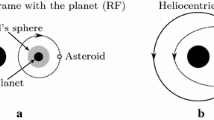Abstract
In this investigation we treat a special configuration of two celestial bodies in 1:1 mean motion resonance namely the so-called exchange orbits. There exist—at least—theoretically—two different types: the exchange-a orbits and the exchange-e orbits. The first one is the following: two celestial bodies are in orbit around a central body with almost the same semi-major axes on circular orbits. Because of the relatively small differences in semi-major axes they meet from time to time and exchange their semi-major axes. The inner one then moves outside the other planet and vice versa. The second configuration one is the following: two planets are moving on nearly the same orbit with respect to the semi-major axes, one on a circular orbit and the other one on an eccentric one. During their dynamical evolution they change the characteristics of the orbit, the circular one becomes an elliptic one whereas the elliptic one changes its shape to a circle. This ‘game’ repeats periodically. In this new study we extend the numerical computations for both of these exchange orbits to the three dimensional case and in another extension treat also the problem when these orbits are perturbed from a fourth body. Our results in form of graphs show quite well that for a large variety of initial conditions both configurations are stable and stay in these exchange orbits.


















Similar content being viewed by others
Notes
Note that for the semi-major axis of P1 we have taken \(1~\text{ AU }-\delta a_{P1}\) and for P2 1 AU \(+\) \(\delta a_{P1}.\)
\(\mu =M_{Planet}/(M_{Planet}+M_{Star})\), where \(M_{Planet} = M_{Planet1} = M_{Planet2}.\)
In this study we were interested whether two terrestrial planets can perform a stable xch-e motion when a perturbing body is present.
References
Alexandersen, M., Gladman, B., Greenstreet, S., Kavelaars, J.J., Petit, J.-M.: The first known Uranian Trojan and the frequency of temporary giant-planet co-orbitals, eprint arXiv: 1303.5774 (2013)
Auner, G.: Exchange orbits. In: Freistetter et al. (eds.) Proceedings of the 2nd Austrian Hungarian Workshop on Trojans and Related Topics, Eötvös University Press Budapest, 49 (2001)
Barrabés, E., Mikkola, S.: Families of periodic horseshoe orbits in the restricted three-body problem. Astron. Astrophys. 432, 1115 (2005)
Delva, M.: A Lie integrator program and test for the elliptic restricted three body problem. Astron. Astrophys. 60, 277 (1985)
Dermott, S.F., Murray, C.D.: The dynamics of tadpole and horseshoe orbits II. The coorbital satellites of saturn. Icarus 48, 12 (1981)
Dvorak, R., Pilat-Lohinger, E., Funk, B., Freistetter, F.: Planets in habitable zones: a study of the binary gamma Cephei. Astron. Astrophys. 398, L1 (2003)
Dvorak, R., Freistetter, F.: Orbit dynamics, stability and chaos in planetary systems. In: Dvorak et al. (eds.) LNP, vol. 683, 3 (2005)
Dvorak, R.: Exchange orbits in planetary systems. In: Freistetter et al. (eds.) Proceedings of the 4th Austrian Hungarian Workshop on Trojans and Related Topics, Eötvös University Press Budapest, 63 (2006)
Dvorak, R., Bazsó, Á., Zhou, L.-Y.: Where are the Uranus Trojans? Celest. Mech. Dyn. Astron. 107, 51–62 (2010)
Eggl, S., Dvorak, R.: An introduction to common numerical integration codes used in dynamical astronomy. LNP 790, 431 (2010)
Funk, B., Schwarz, R., Dvorak, R., Roth, M.: Exchange orbits: a possible application to extrasolar planetary systems? Mon. Not. R. Astron. Soc. 410, 455 (2011)
Giuppone, C.A., Beaugé, C., Michtchenko, T.A., Ferraz-Mello, S.: Dynamics of two planets in co-orbital motion. Mon. Not. R. Astron. Soc. 407, 390 (2010)
Hadjidemetriou, J.D., Psychoyos, D., Voyatzis, G.: The 1/1 resonance in extrasolar planetary systems. Celest. Mech. Dyn. Astron. 104, 23–38 (2009)
Hadjidemetriou, J.D., Voyatzis, G.: The 1/1 resonance in extrasolar systems. Migration from planetary to satellite orbits. Celest. Mech. Dyn. Astron. 111, 179–199 (2011)
Hanslmeier, A., Dvorak, R.: Numerical integrations with Lie-series. Astron. Astrophys. 132, 203 (1984)
Laughlin, G., Chambers, J.E.: Extrasolar trojans: the viability and detectability of planets in the 1:1 resonance. Astrophys. J. 124, 592 (2002)
Lichtenegger, H.: The dynamics of bodies with variable masses. Celest. Mech. 34, 357 (1984)
Llibre, J., Ollé, M.: The motion of Saturn coorbital satellites in the restricted three-body problem. Astron. Astrophys. 378, 1087 (2001)
Nagy, I., Süli, Á., Érdi, B.: A stability study of Pluto’s moon system. Mon. Not. R. Astron. Soc. 370, L19 (2006)
Nauenberg, M.: Stability and eccentricity for two planets in a 1:1 resonance, and their possible occurrence in extrasolar planetary systems. Astron. J. 124, 2332 (2002)
Roth, M.: Extrasolare Planeten in der 1:1 Resonanz, Master Thesis, University of Vienna (2009)
Spirig, F., Waldvogel, J.: The three-body problem with two small masses. In: Szebehely, V.G. (ed.) Stability of the Solar System and its Minor Natural and Artificial Bodies, Reidel Publishing Company, Dordrecht, vol. 53 (1985)
Süli, Á., Dvorak, R., Freistetter, F.: The stability of the terrestrial planets with a more massive ‘Earth’. Mon. Not. R. Astron. Soc. 363, 241 (2005)
Waldvogel, J., Spirig, F.: Co-orbital satellites and Hill’s lunar problem. In: Roy, A.E. (ed.) Long-Term Dynamical Behaviour of Natural and Artificial N-Body Systems, p. 223. Kluwer, Netherlands (1988)
Yoder, C.F., Colombo, G., Synnott, S.P., Yoder, K.A.: Theory of motion of Saturns coorbiting satellites. Icarus 53, 431 (1983)
Yoder, C.F., Synnott, S.P., Salo, H.: Orbits and masses of Saturn’s co-orbital satellites, Janus and Epimetheus. Astron. J. 98, 1875 (1989)
Acknowledgments
BF and RS wants to acknowledge the support by the Austrian FWF project P23810-N16. RD wants to acknowledge the support by the Austrian FWF NFN project S 11603-N16.
Author information
Authors and Affiliations
Corresponding author
Rights and permissions
About this article
Cite this article
Funk, B., Dvorak, R. & Schwarz, R. Exchange orbits: an interesting case of co-orbital motion. Celest Mech Dyn Astr 117, 41–58 (2013). https://doi.org/10.1007/s10569-013-9497-4
Received:
Revised:
Accepted:
Published:
Issue Date:
DOI: https://doi.org/10.1007/s10569-013-9497-4




